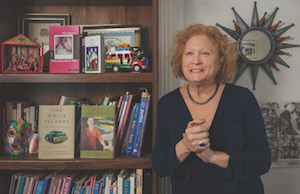LENS Arts, Humanities and Social Sciences
Amplifying Voices
Translations that Broaden the Reach of Women Writers
 PHOTO: Matt Shiffler
PHOTO: Matt ShifflerJacqueline Nanfito, associate professor
Jacqueline Nanfito, PhD, an associate professor of Spanish at Case Western Reserve, has been writing about and translating the work of Latin American women writers for the past three decades. One of her most recent translations is of Las Islas Blancas (The White Islands), a 2016 collection of poetry by Chilean author and human rights activist Marjorie Agosin (HON '14). She's currently working on a translation of Hasta Ya No Ir y Otros Cuentos (Til She Go No More and Other Texts), a collection of four novellas by Chilean writer Beatriz Garcia Huidobro. And as someone who gives women writers a broader audience, Nanfito has definite thoughts about the current reckoning over sexual harassment in the United States.*
Why do you translate Latin American writers?So many Latin American women writers were unread and I wanted to rescue them from oblivion. I thought, "What better way than to translate them into English?"
What are some of the challenges in translating these works?When you compare Spanish and English, English is so much more precise and almost very narrow, whereas Spanish is baroque and it just overflows. To not lose that baroque style, which sometimes seems a little wordy in English, and to keep it faithful to the meaning of the author, that is one of the biggest challenges for me.
I work closely with the authors, who are contemporaries. I'm never happy with one sit-down translation. I go back and revise and wordsmith. I'll give it to the author and ask for feedback and incorporate it into the translation. These authors do read English, though limited, but prefer to write in their native tongue.
Why is it important to you to give these writers a broader international audience?I just feel that women, especially Latin American women and women in Third World countries, are often marginalized and their voices are silenced or simply not heard. My first book was El Sueno, or The Dream, by a 17th-century baroque Mexican named Sor Juana Ines de la Cruz. She had the largest library in all of Latin America, the New World, at the time. Sor Juana has always been prominent in anthologies, but many other Latin American women writers have not been anthologized. For me, it's really important to do justice to their work.
What's the most gratifying experience you've had translating others' work?The friendships I have with these wonderful contemporary Latin American women authors.
Do the public conversations we're having in the U.S. right now about sexual harassment resonate with you?Absolutely. You have to realize that so many Latin American women writers—they're taught to be submissive, not to speak up. The men, because they're machista, are very domineering. They can be violent, and their virility is very important.
Is it changing?There have been nine female presidents in Latin America. That's the irony of it. We don't consider ourselves a very machista country, but we have yet to elect a female president. Latin American societies are patriarchal, but there's something about women; they're the glue that holds the fabric of society together. Even though men are out there in the public sphere, women have helped dictatorships move into democracies.
Where did you grow up?Omaha, Nebraska, as the youngest of six. My father was an international attorney, and I would often go from college to Latin America to meet him. He had cases in Colombia and in Mexico.
Was there an experience then that drew you to Latin American culture?My father—this crazy Sicilian—after these cases, would rent a car and drive the back roads of Mexico. One time, we came across a wine festival in a little town, and we walked into a store. It was all Mexican folk art and I fell in love. It's such an expression of Latin American identity and so important in Latin America. They embrace popular art.
*The conversation was edited for length.





